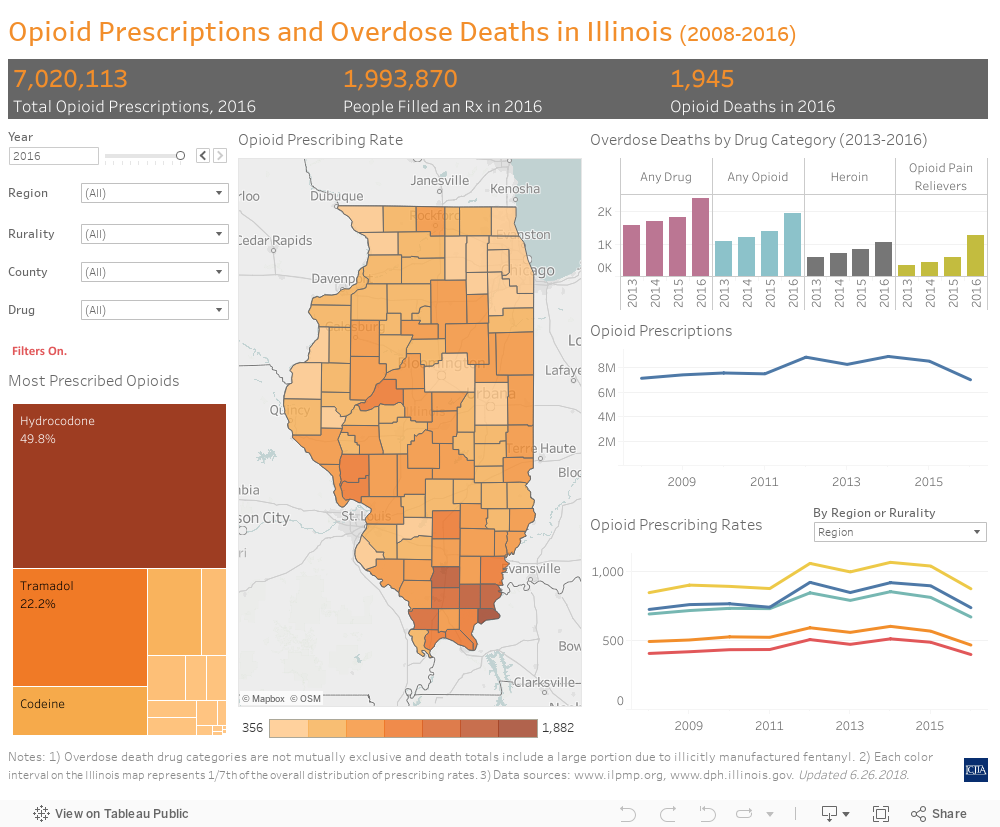Illinois Opioid Prescription Data
Introduction
Healthcare practitioners wrote 259 million prescriptions for opioid pain medication in 2012, enough for almost a full bottle of pills for every adult in the country.[1] Illinois opioid prescribing rates are relatively low compared to other states. According to the Centers for Disease Control and Prevention, Illinois ranked 41st out of 50 states and the District of Columbia on opioid prescription rates.[2] A great deal of variation exists in the rate of opioid prescription across Illinois regions and between counties, however.
Most who rely on opioid use for treatment of chronic pain over an extended period of time never misuse opioids or develop an opioid use disorder.[3] Opioid-related drug overdose deaths in Illinois markedly increased from 2015 to 2016. In 2014, 61 percent of all U.S. overdose deaths involved some type of opioid compared to 70 percent in Illinois.[4]
This interactive data dashboard illustrates opioid prescribing practices in Illinois between 2008 and 2016 and drug overdose deaths from 2013 to 2016.
Data Notes
- Total opioid prescriptions includes all opioid prescriptions filled at commercial pharmacies. One individual may fill more than one opioid prescription in a single year. Opioid prescriptions that were written but never filled were not included.
- Rates are per 1,000 pop.
- County ranks are ordered with “1” denoting the highest value.
- Overdose death drug category data were collected from death certificates.
- Because more than one type of drug could have been a contributing factor in an overdose at the time of death, categories are not mutually exclusive.
- Lab testing for heroin is limited, causing some overdose deaths to be incorrectly attributed to morphine (included here in the “opioid pain relievers” category).[5] The number of heroin overdoses may be higher than what the data indicate.
- Data suggests the vast majority of fentanyl overdoses (included here in the categories of “any opioid” and “opioid pain relievers”) are due to illicitly manufactured fentanyl rather than fentanyl originating from a prescription/pharmacy.[6]
- Some totals presented for the number of prescriptions may differ from the totals presented in other sources published by the Illinois Department of Public Health due to a recent change in the definition of “new prescriptions.” Specifically, refill prescriptions, including those that require a new written prescription from a doctor, are no longer counted as unique prescriptions. Complete data that reflects the new definition was not available to ICJIA prior to the publication of this visualization.
Data Sources
- Opioid prescription data were retrieved from www.ilpmp.org.
- Drug overdose death data were retrieved from www.dph.illinois.gov.
Paulozzi, L. J., Mack, K. A., Hockenberry, J. M. (2014). Vital signs: variation among states in prescribing of opioid pain relievers and benzodiazepines—United States, 2012. Morbidity and Mortality Weekly Report, 63, 563–8. ↩︎
Centers for Disease Control and Prevention. (n.d.). U.S. state prescribing rates, 2016. Retrieved from https://www.cdc.gov/drugoverdose/maps/rxstate2016.html ↩︎
Grau, L. E., Dasgupta, N., Harvey A. P., Irwin, K., Givens, A., Kinzly, M. L., & Heimer, R. (2007). Illicit use of opioids: Is OxyContin a “gateway drug”? American Journal of Addiction, 16, 166-173.; Muhuri, P. K., Gfroerer, J. C., & Davies, M. C. (2013). Associations of nonmedical pain reliever use and initiation of heroin use in the United States. Rockville, MD: Substance Abuse and Mental Health Services Administration, Center for Behavioral Health Statistics and Quality. ↩︎
Starner, C. I., & Gleason, P. P. (2016). Short acting, long acting and abuse-deterrent opioid utilization patterns among 15 million commercially insured members. Prime Therapeutics. Retrieved from https://www.primetherapeutics.com/content/dam/corporate/Documents/Newsroom/PrimeInsights/2016/AMCP16FL-opioids.pdf ↩︎
Illinois Department of Public Health Division of Health Data and Policy (2017). Drug overdose deaths by sex, age group, race/ethnicity and county, Illinois residents, 2013-2016. (Data Notes). Retrieved from http://www.dph.illinois.gov/sites/default/files/publications/Drug-Overdose-Deaths-December2017.pdf ↩︎
Sommerville, N. J., O’Donnell, J., Gladden, R. M., Zibbell, J. E., Green, T. C., Younkin, M., Ruiz, S., Babakhanlou, H., Chan, M., Callis, B. P., Kuramoto-Crawford, J., Nields, H. M., & Walley, A. Y. (2017). Characteristics of fentanyl overdose — Massachusetts, 2014–2016. Morbidity and Mortality Weekly Report, 66, 382-386. ↩︎
Justin Escamilla is a Research Analyst in ICJIA's Center for Justice Research and Evaluation.
Alysson Gatens is a Research Analyst in ICJIA's Center for Justice Research and Evaluation.
